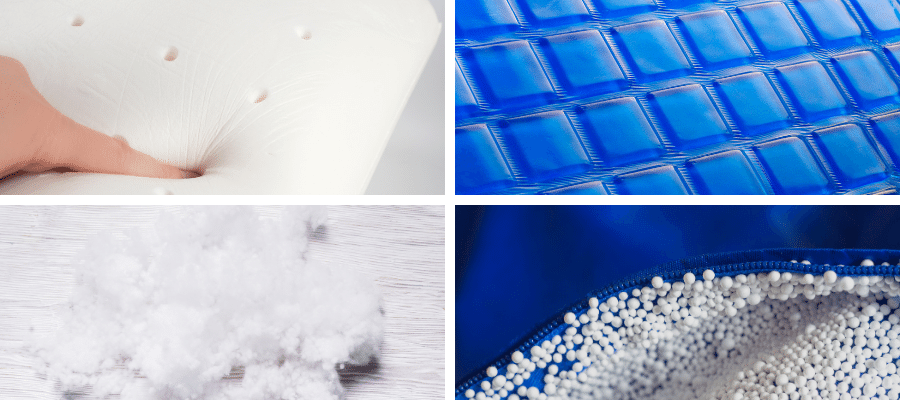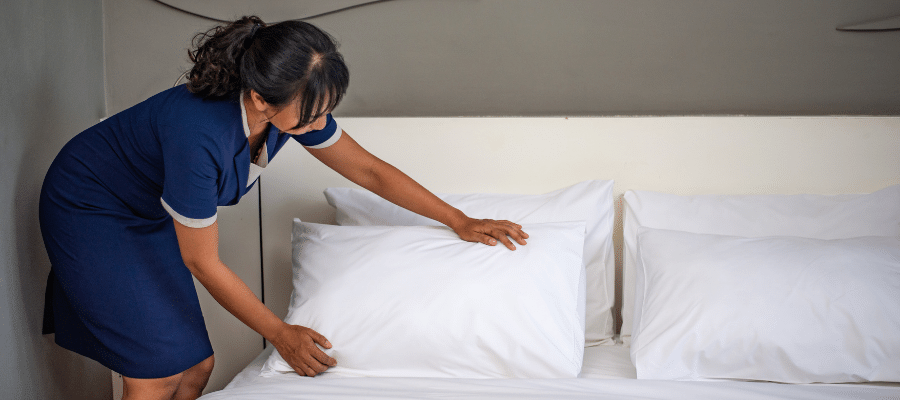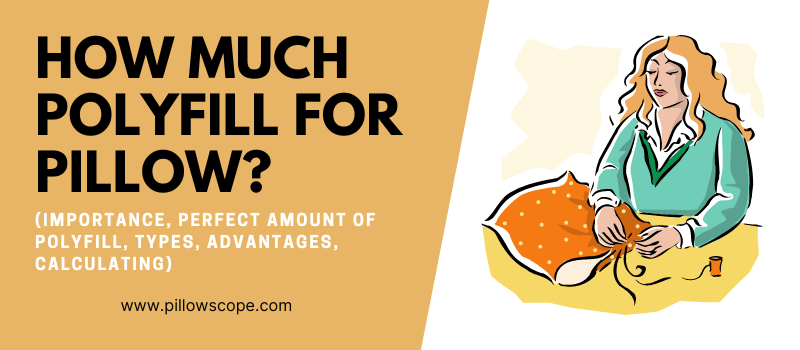The amount of polyfill within pillows considerably impacts their level of comfort and support, which is crucial for getting a good night’s sleep. Have you ever wondered, “How much polyfill is perfect for my pillow?” Well, you’re in the right place.
We’ll explore the science of pillow comfort in this extensive article and provide information on calculating the right amount of polyfill for your pillow. We’ve got you covered, from the factors influencing the amount of polyfill to frequently asked questions.
Importance of Pillow Comfort and Support
Have you ever had a stiff neck or a bothersome headache upon waking? The problem might be with your pillow. A good night’s sleep isn’t just simply the number of hours you sleep in bed; it’s also about the type of sleep you experience. Two important components that contribute to this quality are comfort and support.
A comfortable pillow provides a soft, inviting surface to rest your head on. It should gently cradle your head and neck, relaxing your muscles. On the other hand, support refers to the ability of the pillow to maintain the natural alignment of your spine. It ensures that your neck and head are supported adequately during sleep, minimizing strain on your muscles and reducing the risk of waking up with aches and pains.
Role of Polyfill in Pillow Construction
Polyfill, also known as polyester fiberfill, is a synthetic material often used to make pillows. It is essential because it helps pillows strike the right balance between comfort and support. Polyfill is soft and flexible, making it an excellent choice for pillows because molding it to the shape of your head and neck is simple. It allows for a personalized sleeping experience.
Polyfill is appropriate for allergy sufferers since it has hypoallergenic qualities. Dust mites and other allergens that might reduce the quality of your sleep are resistant to it. Moreover, polyfill pillows are typically less expensive than natural alternatives, making them more accessible to many people.
Determining the Right Amount of Polyfill for Your Pillow
Finding the perfect pillow often boils down to finding the right amount of polyfill. While there is no one-size-fits-all answer, here are some guidelines to help you determine the optimal level of polyfill for your needs.
- Sleeping Position: Your preferred sleeping position plays a significant role. Back sleepers require less loft (height) in their pillows, while side sleepers may benefit from a higher loft to keep the spine aligned.
- Pillow Loft: The loft of a pillow refers to its thickness. Low loft pillows are flatter, medium loft pillows have a moderate thickness, and high loft pillows are thicker. Choose based on your sleeping style and comfort preference.
- Personal Feel: Your comfort matters most. Lie on the pillow and assess if it feels too firm, soft, or right. Adjust the amount of polyfill accordingly.
- Trial and Error: It’s okay to experiment. Some pillows come with a zipper that allows you to add or remove polyfill until you find your ideal comfort level.
What is Polyfill?
Polyfill, short for “polyester fiberfill,” is a synthetic material that has revolutionized pillow construction. It’s made from polyester fibers that are processed and manipulated to create a fluffy and resilient filling. Its purpose is to imitate natural materials’ softness and comfort while providing extra benefits to accommodate different sleep preferences.
Different Types of Polyfill Materials

Standard Polyfill:
The most popular kind of polyfill is this one, which is valued for both its cost and adaptability. It is ideal for various sleepers since it offers a well-balanced combination of softness and support.
Memory Foam Polyfill:
This provides a unique mix of contouring comfort and soft support by combining memory foam shreds with conventional polyfill. It adjusts according to your head shape and delivers a distinctive sleeping experience.
Gel-Infused Polyfill:
Gel-infused polyfill incorporates gel beads into the polyester fibers. This addition enhances breathability and temperature regulation, keeping you cool throughout the night.
Microfiber Polyfill:
Microfiber polyfill consists of ultra-fine fibers that mimic the texture of natural down. It’s incredibly soft and lightweight, providing a luxurious sleeping surface.
Advantages of Using Polyfill in Pillows
- Affordability: Polyfill pillows are generally more budget-friendly than natural alternatives like down or feather pillows.
- Hypoallergenic: Unlike feather pillows, polyfill pillows resist common allergens such as dust mites and pet dander.
- Customizable Support: Polyfill is malleable, allowing you to shape and adjust your pillow for optimal comfort and support.
- Consistent Loft: Polyfill maintains its loft (thickness) over time, ensuring constant support and cushioning.
- Easy Maintenance: Most polyfill pillows are machine washable, making them convenient to clean and maintain.
- Variety of Options: With various types of polyfill to choose from, you can find a pillow that suits your preferred sleeping position and comfort level.
- Eco-Friendly Options: Some polyfill materials are made from recycled polyester, contributing to sustainability efforts.
Factors Influencing Polyfill Quantity in Your Pillow
Pillow Size and Dimensions
The size and dimensions of your pillow play a significant role in determining the required amount of polyfill. More giant pillows, such as king-sized pillows, naturally need more polyfill to maintain their loft and support. Smaller pillows, like standard or travel-sized ones, require less polyfill to achieve the same comfort level.
Desired Firmness and Loft
Firmness and loft refer to how soft or firm the pillow feels and how high or thick it is. These factors are highly individual and depend on your personal preferences for a comfortable night’s sleep.
Firmness
If you prefer a firmer pillow, you’ll need less polyfill to achieve that level of support. Conversely, a softer pillow will require more polyfill to create a plush sleeping surface.
Loft
The loft of your pillow is crucial for proper spinal alignment. Back sleepers generally require lower loft pillows, while side sleepers benefit from higher loft to fill the gap between the head and shoulder.
Sleeper’s Preferences (Back, Side, Stomach)
Your preferred sleeping position significantly influences the amount of polyfill you need in your pillow.
- Back Sleepers: Back sleepers typically require less polyfill as they need moderate support to maintain a neutral spine position.
- Side Sleepers: Side sleepers should opt for pillows with a higher loft and more polyfill to adequately support the head and neck.
- Stomach Sleepers: Stomach sleepers often need the least polyfill, as excessive loft can strain the neck and back in this position.
Types of Pillow Covers
The type of pillow cover you use can affect how the polyfill feels. Pillow covers made from materials like cotton, bamboo, or microfiber can impact the breathability and heat retention of the pillow. Depending on your preference, you may need to adjust the polyfill quantity to compensate for the cover’s influence on temperature and comfort.
Longevity and Maintenance of the Pillow
Due to regular use, polyfill pillows may eventually lose their loft or compress. Periodically adding additional polyfill will keep the pillow’s supportiveness. Regular cleaning and fluffing also help extend the pillow’s life and ensure that the polyfill is still evenly dispersed.

Tips for Maintaining Your Polyfill Pillow
The best performance of polyfill pillows depends on regular maintenance. Here are some suggestions for care.
Regular Fluffing
Fluffing your polyfill pillow is a simple yet effective way to maintain its loft and support. Give your pillow a good shake and knead it gently to redistribute the polyfill fibers evenly. This prevents clumping and ensures consistent comfort.
Pillow Protectors
Using a pillow protector is a smart investment. A pillow protector protects against sweat, oils, and dust, keeping your pillow cleaner for longer. It’s easier to wash or replace a protector than the entire pillow.
Washing Instructions
If you would like to find out how to wash your pillow, please check the care label. Some polyfill pillows are machine washable, while others may require spot cleaning. Follow the recommended care instructions to maintain the pillow’s integrity.
Gentle Washing
Use a soft cycle and light detergent if your polyfill pillow can be washed in the washing machine. Ensure the pad is thoroughly dry before reusing it to prevent mold and mildew growth.
Sun and Air
Sunlight and fresh air are natural disinfectants. Occasionally, place your pillow in a well-ventilated area exposed to sunlight to help eliminate moisture and odors. Avoid overexposing it to direct sunlight, as excessive heat can damage the polyfill.
Tapping and Flipping
Tap and gently pat your pillow along its length to prevent the polyfill from settling in one area. Flipping your pillow occasionally helps maintain an even distribution of the polyfill.
Avoiding Excessive Force
Avoid subjecting your polyfill pillow to excessive force or pressure, such as jumping on it or sitting on it regularly. This can cause the polyfill to compress and lose its loft.
Replacing When Needed
Even with proper maintenance, pillows have a limited lifespan. If your polyfill pillow shows signs of lumps, unevenness, or decreased support, it might be time to replace it to ensure you continue to enjoy quality sleep.
Professional Cleaning
For pillows that can’t be machine washed, consider professional cleaning services. They can clean and sanitize your pillow effectively without compromising its integrity.
Use a Pillowcase
Using a pillowcase adds a personal touch to your bed and protects the pillow from body oils and dirt. Wash the pillowcase regularly to maintain a clean sleeping environment.
How Polyfill Affects Pillow Comfort
Polyfill, or polyester fiberfill, is a synthetic material that brings versatility to pillow construction. Its unique properties impact pillow comfort in multiple ways:

Plushness:
Polyfill’s soft and malleable nature contributes to the pillow’s plushness. The fibers gently bounce back when compressed, creating a cozy and inviting surface.
Conformity:
Polyfill fits readily to the shape of your head and neck, encouraging optimal spinal alignment. This conformance aids in the uniform distribution of pressure and the reduction of stress on muscles and joints.
Customization:
The amount of polyfill in a pillow can be adjusted to customize comfort and support. This adaptability caters to individual sleep preferences.
Breathability:
Some polyfill materials are designed to improve breathability, preventing the development of heat and moisture that can disrupt sleep.
Finding the Balance Between Softness and Support
Comfortable pillows need the right softness and support for proper spinal alignment. Polyfill is key.
Softness:
The plushness of polyfill creates a gentle surface for your head. It cushions pressure points and provides that initial cozy feeling.
Support:
The loft (thickness) of the pillow determines its supportiveness. With proper loft, the pillow keeps the head and neck aligned with the spine, preventing strain and discomfort.
Avoiding Overstuffing and Underfilling Issues
Both overstuffing and underfilling a pillow can compromise comfort and support. Finding the middle ground is essential:
- Overstuffing: Too much polyfill leads to excessive loft, causing the neck to bend unnaturally. This strains muscles and can result in discomfort and pain.
- Underfilling: Insufficient polyfill reduces the pillow’s ability to support the head and neck adequately. This can lead to inadequate spinal alignment and discomfort.
Calculating the Right Polyfill And How Much Polyfill for Pillow
Polyfill is crucial in determining the comfort and support of various pillow types, from standard and king-sized pillows to decorative throws and body pillows. Let’s look at how to determine the right amount of polyfill for each type of pillow so that you have the ideal balance.

Standard/Queen Size Pillows
Step 1: Measure the pillow’s dimensions (length, width, and height). For standard/queen pillows, these dimensions are typically around 20 x 30 inches.
Step 2: Determine the desired loft (height) of the pillow. A typical loft for standard/queen pillows is around 4 to 6 inches.
Step 3: Calculate the volume of the pillow by multiplying its length, width, and height. For example, if your pillow measures 20 x 30 x 6 inches, the book is 3,600 cubic inches.
Step 4: Estimate the required polyfill based on the volume. A general guideline is to use 0.5 to 0.7 ounces of polyfill per cubic inch. Using 0.6 ounces per cubic inch, you would need 3,600 x 0.6 = 2,160 ounces (or approximately 135 pounds) of polyfill.
King Size Pillows
Step 1: Measure the pillow’s dimensions, which are typically around 20 x 36 inches for king-sized pillows.
Step 2: Determine the desired loft. King-sized pillows often have a loft of 6 to 8 inches.
Step 3: Calculate the volume of the pillow (length x width x height). For instance, if your pillow measures 20 x 36 x 8 inches, the volume is 5,760 cubic inches.
Step 4: Estimate the required polyfill based on the volume. Using the guideline of 0.5 to 0.7 ounces per cubic inch, you would need 5,760 x 0.6 = 3,456 ounces (or approximately 216 pounds) of polyfill.
Decorative Throw Pillows
Step 1: Measure the dimensions of the throw pillow cover. Standard sizes for decorative throw pillows include 16 x 16 and 18 x 18 inches.
Step 2: Determine the desired loft. Decorative pillows often have a loft of 2 to 4 inches.
Step 3: Calculate the volume of the pillow (length x width x height). For example, if your throw pillow cover measures 16 x 16 x 3 inches, the volume is 768 cubic inches.
Step 4: Estimate the required polyfill based on the volume. Using the guideline of 0.5 to 0.7 ounces per cubic inch, you would need 768 x 0.6 = 460.8 ounces (or approximately 28.8 pounds) of polyfill.
Body Pillows
Step 1: Measure the dimensions of the body pillow. Standard body pillow sizes are around 20 x 54 inches.
Step 2: Determine the desired loft. Body pillows typically have a loft of 6 to 8 inches.
Step 3: Calculate the volume of the pillow (length x width x height). For instance, if your body pillow measures 20 x 54 x 8 inches, the volume is 8,640 cubic inches.
Step 4: Estimate the required polyfill based on the volume. Using the guideline of 0.5 to 0.7 ounces per cubic inch, you would need 8,640 x 0.6 = 5,184 ounces (or approximately 324 pounds) of polyfill.
Remember that these calculations are rough estimates, and the amount of polyfill you use may vary depending on your preference for pillow firmness and the compressibility of the polyfill material. Adjust as needed to achieve your desired level of comfort and support.
Step-by-Step Guide: Determining the Right Polyfill Amount
Polyfill is necessary to create comfortable and supportive pillows. Follow these steps to determine the right amount of polyfill for a restful sleep.
Step 1: Measuring the Pillow’s Dimensions
- Length, Width, and Height: Start with determining your pillow’s measurements. It includes its length, width, and height. You may estimate the volume of the cushion using these measures.
Step 2: Choosing the Appropriate Polyfill Density
- Determine the Desired Loft: Keep in mind both your slumbering position and personal preferences. The loft, or thickness, of the pillow is crucial. Back sleepers may prefer a lower loft, while side sleepers might need a higher loft for proper neck support.
- Polyfill Density: The density of various varieties of polyfill varies. Use polyfill with a lower density if you want a fluffy, soft cushion. Choose a higher-density polyfill for a firmer feel.
Step 3: Filling the Pillow Evenly
- Calculate Pillow Volume: Multiply the pillow’s length, width, and height to find its volume in cubic inches or centimeters. This will be the space you need to fill with polyfill.
- Estimate Polyfill Amount: Refer to the polyfill manufacturer’s guidelines for the recommended amount of polyfill per cubic inch or cubic centimeter. It is usually provided on the product packaging.
- Fill Gradually: Add a portion of the estimated polyfill to the pillow. Use your hands to distribute it evenly. Ensure the corners and edges are adequately filled.
- Check for Lumps: Regularly check for lumps or uneven areas while filling. Gently massage the pillow to disperse the polyfill evenly.
- Continue Filling: Gradually add more polyfill until you reach your desired loft and firmness. Remember that you can always add more polyfill if needed, but removing excess is more challenging.
Step 4: Checking Firmness and Making Adjustments
- Test Firmness: Once you’ve filled the pillow, test its firmness by lying on it. Pay attention to how your head and neck feel. The pillow should support your head without causing discomfort.
- Adjust as Necessary: If the pillow feels too soft or lacks support, add more polyfill and redistribute it evenly. If it’s too firm, remove some polyfill and fluff the pillow to maintain consistency.
- Re-Test and Fine-Tune: Lie on the pillow again to assess the changes. Continue to adjust until you achieve the desired firmness and loft.
- Final Check: After making adjustments, check the pillow for lumps or uneven areas. Make sure the polyfill is evenly distributed throughout the pillow.
Expert Insights: Recommendations from Sleep Professionals
Your pillow influences sleep quality. We have expert recommendations to help you find the right pillow for your sleeping position and to support your neck and spine.
Advice from Chiropractors and Orthopedic Specialists
Dr. Lisa Mitchell, Chiropractor:
“Your pillow should complement your sleeping position. For back sleepers, a medium-firm pillow with proper loft maintains spinal alignment. Side sleepers benefit from a higher loft pillow to bridge the gap between the head and shoulder. Stomach sleepers should opt for a soft, low loft pillow to avoid straining the neck.”
Dr. Mark Davis, Orthopedic Specialist:
“When choosing a pillow, consider your neck’s natural curve. A pillow with good support fills the space between your neck and the mattress. Polyfill pillows offer a customizable option for adjusting loft and firmness to match your needs.”
Catering to Different Sleep Positions
Back Sleepers:
- Opt for a medium-firm polyfill pillow with a moderate loft.
- Maintain the natural curve of your neck to prevent strain.
Side Sleepers:
- Choose a high-loft polyfill pillow to keep your head and neck aligned.
- Ensure your spine is straight from head to hips.
Stomach Sleepers:
- Select a soft, low-loft polyfill pillow to avoid excessive neck extension.
- Place a thin pillow under your hips to prevent lower back strain.
Addressing Specific Neck and Spine Needs
Neck Pain:
- Seek a contoured polyfill pillow that supports the cervical spine’s natural curve.
- Ensure the pillow fills the gap between your neck and the mattress.
Spinal Alignment:
- Use a polyfill pillow that maintains proper alignment in all sleep positions.
- The pillow should support the head and neck without tilting or straining.
Posture Support:
- Consider an adjustable polyfill pillow to fine-tune the loft and support.
- Use a knee or body pillow to maintain spine alignment for side sleepers.
Common Mistakes to Avoid When Using Polyfill Pillows
Polyfill pillows provide a comfortable and customizable sleep experience. Avoid common mistakes to maintain optimal comfort and support.

Mistake 1: Overstuffing Leading to Discomfort
The Issue: Adding too much polyfill can lead to an overly firm and uncomfortable pillow. It may cause your head to tilt upward, straining your neck and disrupting sleep.
Solution:
- Follow the recommended guidelines for polyfill quantity based on your pillow’s size and desired loft.
- Remember that more isn’t always better.
- Adjust the polyfill amount gradually to achieve the perfect balance of comfort and support.
Mistake 2: Underfilling Causing Lack of Support
The Issue: Insufficient polyfill results in a pillow that lacks support for your head and neck. This can lead to discomfort, pain, and disrupted sleep.
Solution: Use an appropriate polyfill to maintain the pillow’s loft and support. Regularly fluff your pillow to prevent the polyfill from compressing and losing shape over time.
Mistake 3: Ignoring the Importance of Pillow Maintenance
The Issue: Neglecting proper pillow maintenance can decrease comfort and hygiene. Pillow covers can become soiled, and the polyfill can clump, affecting support and overall sleep quality.
Solution: Use a removable pillow protector to shield the pillow from sweat, oils, and dirt. Follow the manufacturer’s guidelines for washing and drying your pillow. Regularly fluff and adjust the polyfill to keep the pillow’s shape and support intact.
Mistake 4: Not Considering Personal Sleep Preferences
The Issue: Choosing a polyfill pillow based on recommendations or trends requires considering your sleep preferences to avoid discomfort.
Solution: Assess your preferred sleep position, desired firmness, and loft requirements. Customize your polyfill pillow accordingly to ensure it aligns with your comfort needs.
Mistake 5: Using the Wrong Pillow Cover
The Issue: The type of pillow cover you use can affect the breathability and feel of the pillow. An inappropriate cover might hinder your overall sleep experience.
Solution: Opt for a breathable and comfortable pillow cover made from cotton, bamboo, or microfiber materials. This ensures that the cover complements the qualities of the polyfill pillow.
Conclusion
Your pillow’s comfort and support may significantly impact the quality of your sleep. You may construct a pillow that exactly suits your sleep style and preferences by knowing the role of polyfill and adjusting it to your requirements.
FAQs.
Where can I get pillows with adjustable polyfill?
Some bedding stores offer pillows with zippered covers, allowing you to add or remove polyfill as needed.
What’s the average lifespan of a polyfill pillow?
With proper care, a polyfill pillow can last anywhere from 1 to 3 years.
Can I wash a pillow with polyfill?
Many polyfill pillows are machine washable, but always check the care instructions.
Is polyfill safe for people with allergies?
Yes, a polyfill is hypoallergenic and suitable for most individuals with allergies.
How do I know if my pillow has the right amount of polyfill?
Finding the right balance involves considering your sleeping position, loft preference, and personal comfort.

